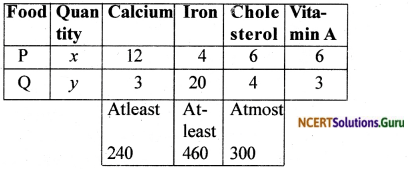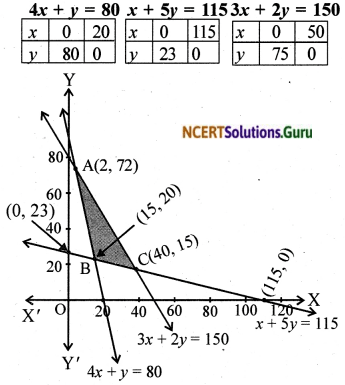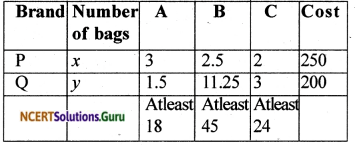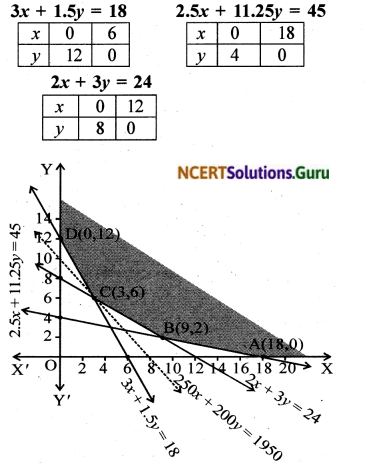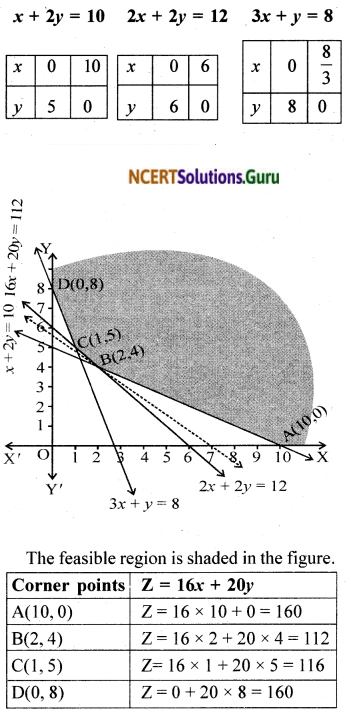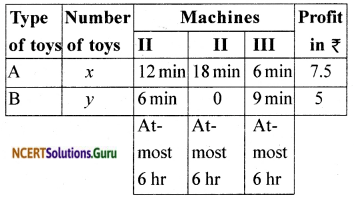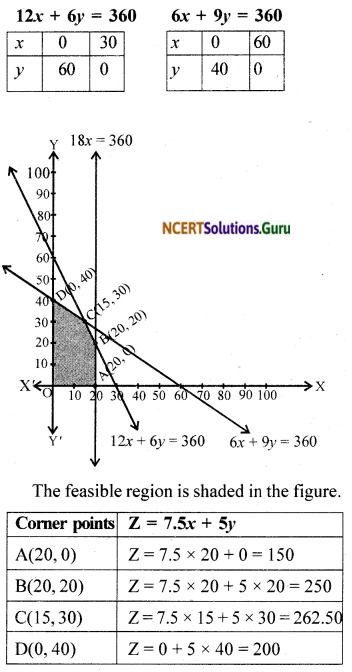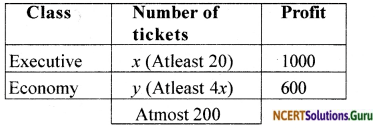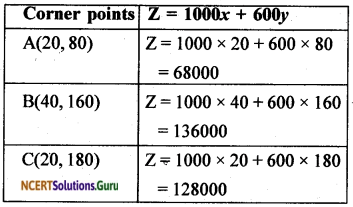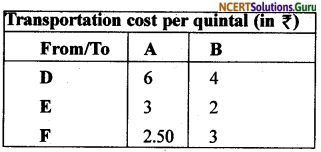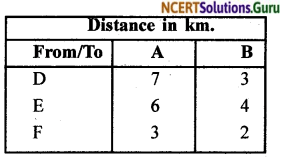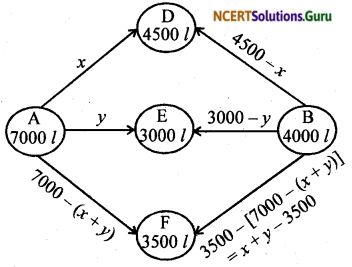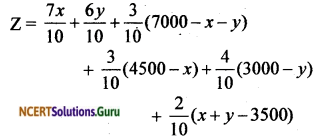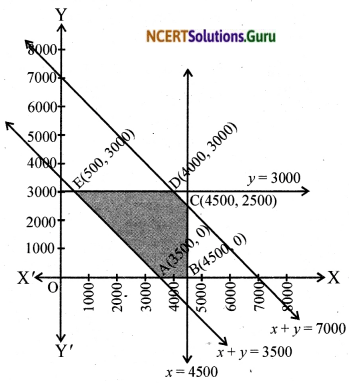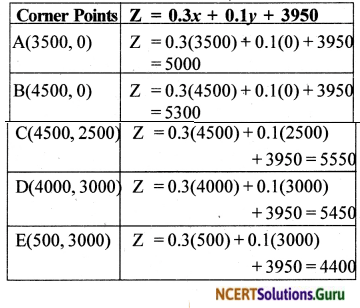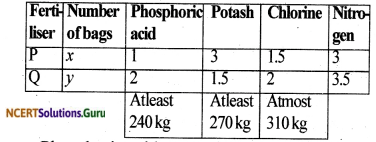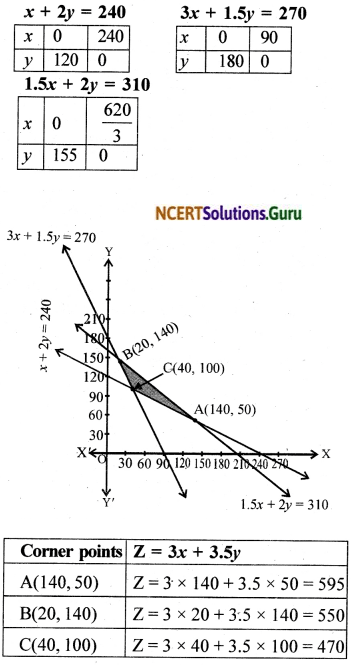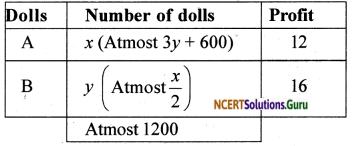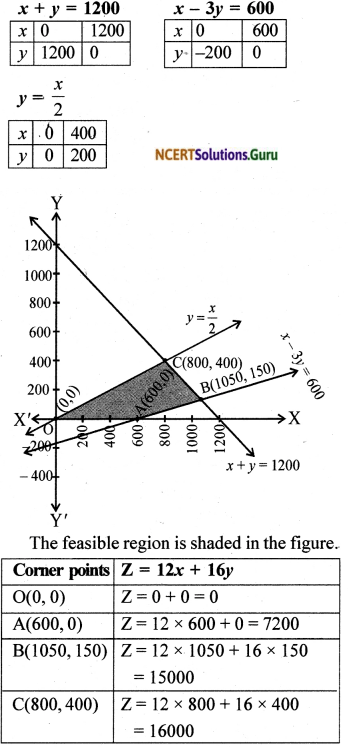NCERT Solutions for Class 12 Maths Chapter 13 Probability Ex 13.5
These NCERT Solutions for Class 12 Maths Chapter 13 Probability Ex 13.5 Questions and Answers are prepared by our highly skilled subject experts. https://mcq-questions.com/ncert-solutions-for-class-12-maths-chapter-13-ex-13-5/
NCERT Solutions for Class 12 Maths Chapter 13 Probability Exercise 13.5
![]()
Question 1.
A die is thrown 6 times. If ‘getting an odd number’ is a success, what is the probability of
(i) 5 successes?
(ii) at least 5 successes?
(iii) at most 5 successes?
Solution:

Question 2.
There are 5% defective items in a large bulk of items. What is the probability that a sample of 10 items will include not more than one defective item?
Solution:
This is a Bernoulli trial with n = 4
Here success is getting a doublet
p = probability of success
= \(\frac { 6 }{ 36 }\) = \(\frac { 1 }{ 6 }\)
q = 1 – p = 1 – \(\frac { 1 }{ 6 }\) = \(\frac { 5 }{ 6 }\)
Let X be the number of successes. Then X is a binomial distribution with

Question 3.
A pair of dice is thrown 4 times. If getting a doublet is considered a success, find the probability, of two successes.
Solution:
This is a Bernoulli trial with n = 10
Here success is the inclusion of a defective item
p = probability of success = \(\frac { 5 }{ 100 }\) = \(\frac { 1 }{ 20 }\)
∴ q = 1 – p = 1 – \(\frac { 1 }{ 20 }\) = \(\frac { 19 }{ 20 }\)
Let X be the number of defective item in the sample.
Then X is a binomial distribution with

![]()
Question 4.
Five cards are drawn successively with replacement from a well- shuffled deck of 52 cards. What is the probability that
(i) all the five cards are spades?
(ii) only 3 cards are spades?
(iii) none is spade?
Solution:
This is a Bernoulli trial with n = 5
Here success is getting a spade
p = probability of success = \(\frac { 13 }{ 52 }\) = \(\frac { 1 }{ 4 }\)
∴ q = 1 – p = 1 – \(\frac { 1 }{ 4 }\) = \(\frac { 3 }{ 4 }\)
Let X denote the number of spade cards.
Then X is a binomial distribution with
n = 5, p = \(\frac { 1 }{ 4 }\) and q = \(\frac { 3 }{ 4 }\)
P(X = x) = \({ }^{n} \mathrm{C}_{x} p^{x} q^{n-x}\)
i. Probability of 5 spades = P(X = 5)

Question 5.
The probability that a bulb produced by a factory will fuse after 150 days of use is 0.05. Find the probability that out of 5 such bulbs.
(i) none
(ii) not more than one
(iii) more than one
(iv) at least one will fuse after 150 days of use
Solution:
This is a Bernoulli trial with n = 5
Here success is the bulb fuse after 150 days.
∴ p = probability of success = 0.05
∴ q = 1 – p = 1 – 0.05 = 0.95
Let X be the number of bulbs fuse after 150 days
Then X is a binomial distribution with n = 5, p = 0.05 and q = 0.95
∴ P(X = x) = \({ }^{n} \mathrm{C}_{x} p^{x} q^{n-x}\)
(i) When X = 0, P(X = 0)
\({ }^{5} \mathrm{C}_{0}(0.05)^{0}(0.95)^{5-0}=(0.95)^{5}\)
(ii) X is not more than 1 i.e. X ≤ 1
∴ P(X ≤ 1) = P(X = 0) + P(X = 1)
= \({ }^{5} \mathrm{C}_{0}(0.05)^{0}(0.95)^{5}+{ }^{5} \mathrm{C}_{1}(0.05)(0.95)^{4}\)
= (0.95)<sup>4</sup> [0.95 + 5 x 0.05]
= (0.95)<sup>4</sup> x 1.2
(iii) X is more than 1 i.e. X > 1
P(X > 1) = 1 – P(X ≤ 1)
= 1 – (0.95)<sup>4</sup> x 1.2 from (ii)
(iv) X is atleast 1 i.e. X ≥ 1
P(X ≥ 1) = 1 – P(X = 0)
= 1 – (0.95)<sup>5</sup> from (i)
![]()
Question 6.
A bag consists of 10 balls each marked with one of the digits 0 to 9. If four bails are drawn successively with replacement from the bag, what is the probability that none is marked with the digit 0?
Solution:
This is a Bernoulli trial with n = 4.
Here success is the ball drawn is marked with number 0
p = probability of success = \(\frac { 1 }{ 10 }\)
∴ q = 1 – p = 1 – \(\frac { 1 }{ 10 }\) = \(\frac { 9 }{ 10 }\)
Let X be the number of balls marked with 0
Then X is a binomial distribution with

In an examination, 20 questions of true-false type are asked. Suppose a student tosses a fair coin to determine his answer to each question. If the coin falls head, he answers ‘true’, if it falls tail, he answers ‘false’. Find
Question 7.
In an examination, 20 questions of true – false type are asked. Suppose a student tosses fair coin to determine his answer to each question. If the coin falls heads, he answers ‘true,’ if it falls tails, he answers “ false’. Find the probability that he answers at least 12 questions correctly.
Solution:
Probability that student answers a question true = \(\frac { 1 }{ 2 }\)
i.e., when a coin is thrown, probability that a head is obtained = \(\frac { 1 }{ 2 }\)
Probability that his answer is false = \(1-\frac { 1 }{ 2 }\) = \(\frac { 1 }{ 2 }\)
Probability that his answer at least 12 questions correctly = P (12) + P (13) + P (14) +…….. P (20)

Question 8
Suppose X has a binomial distribution \(B\left( 6,\frac { 1 }{ 2 } \right) \). Show that X = 3 is the most likely outcome.
(Hint: P (X = 3) is the maximum among all P (Xi), xi. = 0,1,2,3,4,5,6)
Solution:
\({ \left( \frac { 1 }{ 2 } +\frac { 1 }{ 2 } \right) }^{ 6 } \)

Question 9.
On a multiple choice examination with three possible answers for each of the five questions, what is the probability that a candidate would get four or more correct answers just by guessing?
Solution:
P = \(\frac { 1 }{ 3 }\). q = 1 – P = \(1-\frac { 1 }{ 3 }\) = \(\frac { 2 }{ 3 }\)

![]()
Question 10.
A person buys a lottery ticket in 50 lotteries, in each of which his chance of winning a prize is \(\frac { 1 }{ 100 }\) . What is the probability that he will win a prize?
(a) at least once,
(b) exactly once,
(c) at least twice?
Solution:
Probability that the person wins the prize = \(\frac { 1 }{ 100 }\)
Probability of losing = \(1-\frac { 1 }{ 100 }\) = \(\frac { 99 }{ 100 }\)
(a) Probability that he loses in all the loteries

Question 11.
Find the probability of getting 5 exactly twice in 7 throws of a die.
Solution:
S = {1,2,3,4,5,6},n(S) = 6
A = {5} ⇒ n(A) = 1

Question 12.
Find the probability of throwing at most 2 sixes in 6 throws of a single die.
Solution:
When a die is thrown,
Probabiltiy of getting a six = \(\frac { 1 }{ 6 }\)
Probabiltiy of not getting a six = \(1-\frac { 1 }{ 6 }\) = \(\frac { 5 }{ 6 }\)
Probabiltiy of getting at most 2 sixes in 6 throws of a single die = P (0) + P (1) + P (2)

Question 13.
It is known that 10% of certain articles manufactured are defective. What is the probability that in a random sample of 12 such articles 9 are defective?
Solution:
This is a Bernoulli trial with n = 12
Here success is selecting a defective item.
p = probability of success = \(\frac { 1 }{ 100 }\) = \(\frac { 1 }{ 10 }\)
∴ q = 1 – p = 1 – \(\frac { 1 }{ 10 }\) = \(\frac { 9 }{ 10 }\)
Let X is the number of defective items. Then X is a binomial distribution with

![]()
Question 14.
In a box containing 100 bulbs, 10 are defective. The probability that out of a sample of 5 bulbs, none is defective is
(a) \({ 10 }^{ -1 }\)
(b) \({ \left( \frac { 1 }{ 2 } \right) }^{ 5 }\)
(c) \({ \left( \frac { 9 }{ 10 } \right) }^{ 5 }\)
(d) \(\frac { 9 }{ 10 }\)
Solution:
p = \(\frac { 1 }{ 10 }\)
q = \(\frac { 9 }{ 10 }\)
n = 5,
r = 0,
P(X = 0) = \({ \left( \frac { 9 }{ 10 } \right) }^{ 5 }\)
Option (c) is correct
Question 15.
The probability that a student is not a swimmer is \(\frac { 1 }{ 5 }\). Then the probability that out of five students, four are swimmers is:
(a) \({ }^{5} \mathrm{C}_{4}\left(\frac{4}{5}\right)^{4} \frac{1}{5}\)
(b) \(\left(\frac{4}{5}\right)^{4} \frac{1}{5}\)
(c) \({ }^{5} C_{1} \frac{1}{5}\left(\frac{4}{5}\right)^{4}\)
(d) None of these
Solution:
This is Bernoulli trial with n = 5
Here success is that student is a swimmer.
p = probability of success
= 1 – P (not a swimmer) = 1 – \(\frac { 1 }{ 5 }\) = \(\frac { 4 }{ 5 }\)
∴ q = 1 – p = 1 – \(\frac { 4 }{ 5 }\) = \(\frac { 1 }{ 5 }\)
Let X denote the number of swimmers in the group of 5 students
Then X is a binomial distribution with

NCERT Solutions for Class 12 Maths Chapter 13 Probability Ex 13.5 Read More »













